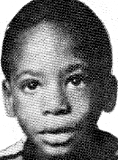Darron Jerome Glass
Darron, circa 1980; Wayne Williams, circa 1980; Williams, circa 2010
- Missing Since 09/14/1980
- Missing From Atlanta, Georgia
- Classification Endangered Missing
- Sex Male
- Race Black
- Date of Birth 05/23/1970 (55)
- Age 10 years old
- Height and Weight 4'9, 75 pounds
- Clothing/Jewelry Description A yellow or brown shirt, brown khaki pants and White sneakers.
- Medical Conditions Darron is mildly mentally disabled, with an IQ of 65.
- Distinguishing Characteristics Black male. Black hair, brown eyes.
Details of Disappearance
Darron's parents are both deceased and he was a ward of the state in 1980. He was living with a foster mother, Fannie Mae Smith, and three other children in the 2200 block of Memorial Drive southeast in Atlanta, Georgia. He had lived with her for less than three months before he disappeared on September 14.
On the day of his disappearance, Darron went downtown to watch a baseball game, then returned home at 4:00 p.m. He left the house again after only a few minutes, and Smith assumed he had gone out to play. Shortly afterwards, Smith said, she got an emergency phone call from someone claiming to be Darron, but the caller hung up before she was able to speak to him and he never called back. Darron has never been heard from again.
Investigators believe Darron may have been a victim of the Atlanta Child Killer, the nickname for a serial killer thought to be responsible for the deaths of over a score of Black children, teens and young adults, mostly boys from poor families, in Atlanta in the early 1980s. The listed victims' ages ranged from seven to twenty-eight years old, and they were killed in a variety of ways. Some were missing for months before their remains were found, but of all the presumed victims, only Darron has never been located.
Wayne Bertram Williams, a music promoter and freelance photographer, was convicted of murdering two of the oldest listed Atlanta victims in 1982. He maintains his innocence in all of the cases.
The presiding judge at his trial allowed prosecutors to bring in evidence linking Williams to the other victims. After his conviction, the police closed the files on the 22 other deaths, concluding that Williams had killed those victims as well. Photographs of Williams are posted with this case summary.
It is worth considering, however, that there are doubts about Williams's guilt and many suspect the Atlanta Child Killer was actually several serial killers operating independently of one another, or even the Ku Klux Klan. One of the police officers on the task force that arrested Williams stated he did not believe Williams had ever killed anyone at all.
Nonetheless, Williams remains in prison and all of his appeals have been rejected. The investigation into five of the Atlanta child murders was reopened in 2005, but it was closed again in 2006 without any new indictments being handed down or new evidence being uncovered.
Smith described Darron as a immature but streetwise child who had many friends. It's unclear whether he had a history as a runaway; some accounts maintain he was a habitual runaway, and others say he had never run away from home. Smith stated he stayed close to home and often brought his friends over. He had lived in another foster home for about a year before moving in with Smith.
According to his caseworker, Thomas Bailey, Darron's foster placement with Smith was quite unsuitable. Bailey stated there were many adults of "questionable character" in the home, and suspicion of drug use and selling. The caseworker stated he voiced his concerns about the placement with his supervisor, but was ignored.
Bailey stated he found out about Darron's disappearance on November 15, the day after it happened. That same day, he got a call from a woman who claimed to be Darron's sister. Darron did have an adult sister, but she lived out of state and Darron was not in contact with her. Bailey said the caller told him she wanted to adopt Darron, but after Bailey told her Darron was missing, the caller hung up without leaving any contact information and never called back.
One of Darron's foster brothers claimed he knew Darron's whereabouts and got calls from him until as late as November 1980, but this was never verified. His status as a victim of the Atlanta Child Killer is tenuous; he was listed only because he fit the profile. Bailey theorizes Darron was not murdered and possibly went to live with his sister after his disappearance, and that he could still be alive.
Darron's case has never been closed. He remains missing and foul play is suspected in his case due to the circumstances involved.
Investigating Agency
- Federal Bureau of Investigation
- Atlanta, Georgia Office
- 404-679-9000
Updated 10 times since October 12, 2004. Last updated June 13, 2024; middle name added.


